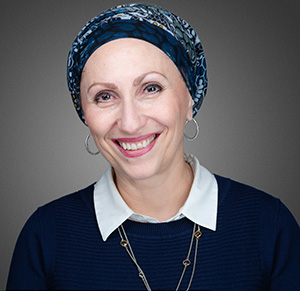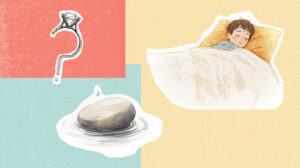Doctor’s Orders


BY MY FLESH I SEE G-D Hylton Lightman knew he wanted to be a doctor since he was five but it took medical school to convince him that G-d runs the world “In our second year we dissected cadavers. I said to myself the body is just too perfect. There must be a Creator” (Photos: Amir Levy)
Y ou could almost miss Dr. Hylton (Chaim Yitzchak) Lightman’s pediatric practice on a quiet street catty-corner from the Torah Academy for Girls elementary school in Far Rockaway. There’s no prominent shingle outside to trumpet his presence just a side door leading into a very ordinary-looking white suburban house.
But Dr. Lightman isn’t a quiet retiring sort not when he has something to say. As one of the most popular pediatricians in Far Rockaway and the Five Towns — evidenced by the bustling practice inside his office — his finger rests quite literally on the pulse of his community. When he encounters problems he doesn’t hesitate to state his piece and step up to the plate.
Take this past March shortly before Purim. “I got disgusted by what Purim has degenerated into ” he says. “Too many boys get dangerously drunk and stop behaving like bnei Torah.” At the invitation of Mesivta Ateres Yaakov he spoke for the second year in a row on Taanis Esther about what will happen if they get so drunk they have to be hospitalized. To drive the point home he brought along the accoutrements of such hospital stays a gastric tube and a Foley catheter and proceeded to explain in chilling graphic detail the painful experience they will endure should such equipment become necessary.
Years earlier after seeing too many cases of domestic abuse Dr. Lightman helped found the Shalom Task Force. He also advocates for changes in the yeshivah system to keep children happier and connected in healthy ways to their Yiddishkeit and serves on the board of Project Extreme which offers wilderness experiences to at-risk teens. During Hurricane Sandy he rigged up a fully functioning pediatric office in Far Rockaway’s White Shul to service patients at a time when no one had electricity water or other basics of life.
Often it’s the outsiders who have the most astute view of a community and Dr. Lightman is not native to these parts: He hails from South Africa and wasn’t raised in the yeshivah system. The path from Johannesburg to Far Rockaway from tradition to full-fledged observance while negotiating medical school and the army is a tale all its own a tale as colorful as the rainbow-striped socks he’s wearing today to the delight of his pint-sized patients.
A Segregated World
Growing up in South Africa in the 1950s and ’60s meant living in a stratified society and not simply because blacks and whites didn’t live together by law.
“Even among whites there was segregation” Dr. Lightman explains. “The English the Afrikaners and the Jews lived separately with little intermarriage. I never interacted in a meaningful manner with an Afrikaner or an Indian person until medical school.”

Dr. Lightman’s office was destroyed in Hurricane Sandy but that didn’t stop him from treating patients by the glow of a flashlight
The public school he attended was largely Jewish and was attached to a shul that offered cheder classes at 7 a.m. to teach basic Hebrew reading and writing.
Due to the influence of the Dutch Reformed Church South Africa was also highly conservative. Books and movies were censored for anti-apartheid ideas or material considered inappropriate; television didn’t come to the country until 1978 and was restricted to three hours daily.
Most Jews were traditional but relatively ignorant of Torah. They’d drive to shul on Friday night make Kiddush and have a meal at home; few returned to shul on Saturday morning. While the shul would be packed with 2 000 families on Rosh Hashanah and Yom Kippur no one knew what Tishah B’Av was.
“When I had my bar mitzvah party on a Saturday evening the rabbi made Havdalah ” Dr. Lightman relates. “But I didn’t know what Havdalah was.”
Dr. Lightman’s grandmother would kasher meat with salt and a bucket and the family observed Pesach with a diet of meat matzah and fruits and vegetables. Though this was the extent of their Jewish knowledge they were proud to be Jews.
Yet his neshamah recognized its unique tafkid from very early on. From the age of five he knew he wanted to be a doctor. As a high school student he would offer a few prayers from his heart to his Creator before school every day already connecting to a spiritual reality.
Medical school only reinforced his conviction that Hashem created the world. “In our second year we dissected cadavers ” he says. “I said to myself the body is just too perfect. There must be a Creator.”
Casting around for ways to access Jewish spirituality he came across a novel that paints a negative misleading portrait of chassidim. But what Lightman did come away with was the idea that Jews are supposed to wear tzitzis. He went to the local Judaica shop and bought himself a pair. It was only later that he realized he’d bought them two sizes too small.
A friend proposed that he spend the summer vacation working with him at a Bnei Akiva camp outside Cape Town where he began building a social circle of other young Jews seeking Judaism. His Jewish learning commenced in earnest in the early 1970s when the Adas Yeshurun community brought ten families from England and Eretz Yisrael to start a kollel.
“It turned over Yiddishkeit in South Africa ” Dr. Lightman recalls. “It wasn’t unusual for 450 people to show up on weeknights for the shiur.”
He already felt committed to growing as a Jew so the kollel’s presence helped him to progress. His parents were generally supportive although they didn’t always take kindly to being informed their butcher wasn’t mehadrin enough or that cheese must have a hechsher.
By late in his third year in medical school he was fully shomer Shabbos but the concept of a shomer Shabbos internship didn’t exist. He landed a prime residency slot at the whites-only Johannesburg General Hospital where he believed he’d have a higher chance of treating (and thereby helping and influencing) Jewish patients. In order to take off for Shabbos he’d work Motzaei Shabbos through Tuesday night then Wednesday morning till 20 minutes before Shabbos.
“Some people took heterim to be able to work on Shabbos but I didn’t want to do that ” he says. “Once I was so exhausted from this schedule I fell asleep while examining an elderly patient. She herself fell asleep in my arms with my stethoscope on her back!”
When he couldn’t avoid being there on Shabbos he worked out a system with the nurses where he’d sign orders in advance and have nurses write his notes under dictation. One Friday night at 3 a.m. he was struggling to retain information from five patients in his head unable to find someone to dictate the information to.
“Suddenly I saw a [non-Jewish] third-year medical student who didn’t even have to be there walk into the ward ” he recounts.
Even more strangely the student told him “I just woke up from a dream that I had to come here.” (Excerpted from Mishpacha Issue 661)
Oops! We could not locate your form.












